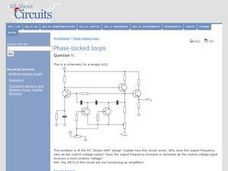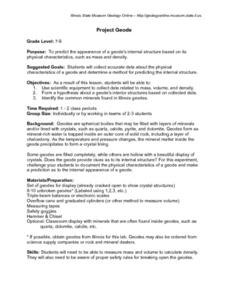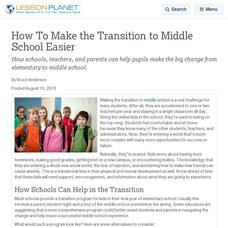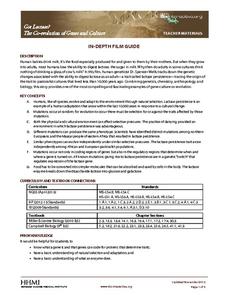Curated OER
Phase-locked Loops
In this physics instructional activity, students examine how phase-locked loop circuits works and answer 8 short answer questions about it. They explain how FM radio communication works.
Curated OER
What's The Scoop?
Students explore the properties of matter. In this cross curriculum three states of matter science lesson, students listen to the poem "Eighteen Flavors" by Shel Silverstein, and predict what will happen if listed ingredients are...
Curated OER
Electromagnets
Students conduct a series of experiments on electromagnets. In this physics lesson, students build their own electromagnet and explain how it works. They determine the factors that affect its strength.
Curated OER
Homopolar Motor Experiments
Learners construct a homopolar motor following certain procedures. In this physics lesson, students explain how generators and motors work. They compare and contrast the characteristics of both.
Curated OER
The Tropopause
In this tropopause worksheet, students read about the temperature of the air in the tropopause or the layer of the atmosphere closest to the Earth. They answer four critical thinking questions about this layer and the energy changes that...
Curated OER
What is an Atom?
Third graders understand that the smallest particle is an atom. In this matter lesson, 3rd graders make a piece of aluminum smaller and smaller to see that what's left is still aluminum. Students recognize that cutting into smaller...
Curated OER
Seeds of Change
Students recognize, compare and contrast physical characterisics of seeds, identify parts of a peanut seed, and observe and record the growth rate and habits of a variety of seeds.
Curated OER
Writing Variable Expressions for Physical Models
Explore the concept of writing variable expressions by examining the similarities between expressions with numbers and expressions with variables. Emerging mathematicians determine rules for sequences and patterns before writing a rule...
Curated OER
Rates of Puberty Change
Eighth graders investigate the reasons for why individuals go through puberty at different times and rates. They conduct a personal worth role play to encourage diversity and self-acceptance. Group discussion is used for scaffolding the...
Perkins School for the Blind
Placemats on Trays
Maybe the idea of putting placemats on trays doesn't sound that great, but it is, especially if you have a physical disability or are visually impaired. This task is one that can be used in a vocational setting and helps develop skills...
Curated OER
Puberty/Adolescence, Day 2: "Who AM I? Where Am I Going?"
A great unit! There is a lot of content that is personal so make sure you have created a safe zone in your classroom before doing this lesson. It will have much more meaning if your learners share their life with others in the class....
Exploratorium
Balancing Stick
Have some physical science fun when studying the center of gravity or center of mass. Simply have balancing artists stand a dowel on one finger and keep it from falling over! A lump of clay is added and moved up along the dowel over a...
Curated OER
Riding on a Pendulum
A comprehensive resource gets fourth grade physical scientists making observations about the period of a pendulum and then applying knowledge to a playground swing. Through seven different stations, they will record observations and...
Curated OER
Chemical Equations and Reactions
Graphic organizers, photos, diagrams, and text bring the world of chemical reactions to life. By viewing this presentation, young chemists learn how to recognize when a chemical reaction has occurred, and how to balance chemical...
Curated OER
Heat Loss and Gain in Physical Changes and Chemical Reactions
Students compare and contrast exothermic and endothermic reactions. In this chemistry lesson, students perform experiments to determine whether heat was released or absorbed in a reaction. They share their observations in class.
Curated OER
Physics- global warming
Students discuss the concept of global warming and view a multimedia clip on the global warming phenomenon. They statistically analyze mean temperature data and compare a given set of data. Data on atmospheric CO2 is done then they...
Curated OER
Project Geode
Young geologists attempt to predict the appearnace of a geode's internal structure based on how it looks from the outside, its mass, and its physical characteristics. In this geologly instructional activity, learners use scientific...
NASA
The Cycle of Matter
An educational lesson focuses on the idea of conservation of matter through a demonstration of the water cycle, a discussion of digesting food, and the path of carbon and oxygen atoms as they change form.
Curated OER
Transportation
Engage in an 8-day study of different modes of transportation. Your students explore the concept of location and define the physical characteristics of places, such as, land forms, bodies of water, natural resources, and weather.
Curated OER
Take-Home Midterm Exam #3
The University of Hawaii has published a vast collection of midterm and final exams for their Physics 152 course. This particular exam offers a variety of assessment methods, and covers the topic of electromagnetic radiation....
Curated OER
Glass Transition in a Rubber Ball
Learners illustrate the changes in the properties of a material at its glass transition point. They gather data which they use to construct graphs regarding elastic modules versus absorption modulus, tangent delta, and the effect of...
Curated OER
How To Make the Transition to Middle School Easier
How schools, teachers, and parents can help pupils make the big change from elementary to middle school.
Howard Hughes Medical Institute
Got Lactase? The Co-Evolution of Genes and Culture
Does the human body evolve as quickly as human culture? With a stellar 15-minute video, explore the trait of lactose intolerance. Only about 1/3 of human adults seem to still have the enzyme lactase and therefore, the ability to digest...
Curated OER
Replacing Missing Links in the Evolutionary Chain
Examine the evolution of various species of hominids from their earliest existence approximately 4.5 million years ago to today. In small groups, learners research one of the ten stages of hominid evolution and then create a poster and...
Other popular searches
- Chemical and Physical Changes
- Physical Changes of Matter
- Matter Physical Changes
- Physical Changes in Matter
- Chemical Physical Changes
- Chemistry Physical Changes
- Chemical or Physical Changes
- Physical Changes of States
- Physical Changes Laboratory
- Physical Changes in Teens
- Matter Physical Changes
- Physical Changes of Water

























